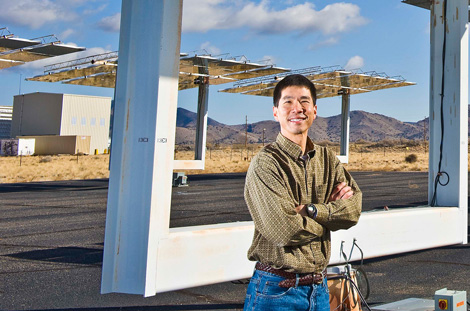Posted on October 11th, 2010 by jxh

Clifford Ho is one young engineer paving the way to sustainable energy solutions.
Ho received the 2010 Asian American Engineer of the Year Award, which honors an Asian American engineer who has made significant, lasting and global contributions to the nation. The recipient is selected by the Chinese Institute of Engineers – USA.
Read More
Filed under: e-News, Electrical, Environmental, Trailblazers | Comments Off on Meet Cliff Ho, Solar Energy Wiz
Tags: Electrical, Environmental, Solar, Trailblazers
Posted on September 30th, 2010 by jxh

Imagine hefting 200 pounds as though it were a mere 12. Raytheon Company has just released a full-body suit that could make the Iron Man fantasy become a reality.
Called the XOS-2 Exoskeleton, it essentially grants the wearer superhuman strength (and also looks really awesome). The new suit has made significant improvements over its predecessor, the XOS-1, which was first demonstrated two and a half years ago.
Read More
Filed under: e-News, Electrical, Mechanical | 4 Comments »
Tags: Electrical, Mechanical, Robotics
Posted on September 22nd, 2010 by jxh

The Army is currently developing tanks that run on hydrogen fuel cells
The U.S. military often struggles – unsuccessfully – to supply enough batteries for troops’ equipment. GPS units and radios demand a lot of energy, so a sustainable source would be really beneficial.
That’s why the U.S. Army has created the Rucksack Enhanced Portable Power System (REPPS), which collects solar energy for the troops in Afghanistan, where there are high levels of sunlight.
The REPPS features a 62-watt, anti-glint solar panel blanket tucked into a backpack. Not only can the system recharge batteries in a matter of hours, it can also be hooked up to electronic devices, providing them with more power.
Read More
Filed under: e-News, Electrical, Environmental | 1 Comment »
Tags: Electrical, Energy, Environmental, Green Technology, Military, renewable energy, Technology
Posted on September 22nd, 2010 by axb

Human skin is extraordinarily sensitive – our fingertips can perceive extremely small differences in pressure, texture, and temperature. Mimicking this ability artificially is a real technological challenge, but fortunately electrical engineers at Stanford and UC Berkeley seem to be up to the task.
At Stanford, a team led by chemical engineering professor Zhenan Bao has developed an artificial skin that is reportedly over 1,000 times more sensitive than its human counterpart. It consists of a thin rubber material placed between two parallel electrodes. When an object touches the skin and compresses the rubber, the surrounding electrodes register this pressure and convert it to electrical signals.
Read More
Filed under: Biomedical, Chemical, e-News, Electrical, Materials | Comments Off on Engineering Artificial Skin
Tags: Biomedical, Chemical, Electrical, Materials, Nanotechnology, Robotics
Posted on September 16th, 2010 by jxh

Find waiting at an empty intersection annoying?
Your driving frustrations may soon be relieved, if city planners adopt a new self-organizing system for traffic lights.
European engineers have designed and tested a system that would give each traffic signal a sensor, to read the current traffic situation, and a computer chip, to calculate the expected flow of vehicles and then determine how long the light should stay green.
Read More
Filed under: Computer, e-News, Electrical, Industrial / Manufacturing, Transportation | 1 Comment »
Tags: Computer, Electrical, Industrial, Transportation













